#improving India-Pak ties
Explore tagged Tumblr posts
Text
Nawaz Sharif: Jaishankar’s Visit Opens Path for India-Pak Relations
Nawaz Sharif praises Jaishankar's visit as a positive start, urging India and Pakistan to move forward, signaling hopes for improved diplomatic relations.
#India-Pakistan dialogue#Nawaz Sharif on peace#Jaishankar visit to Pakistan#diplomatic efforts#improving India-Pak ties#Nawaz Sharif#Jaishankar#India-Pakistan#diplomacy
0 notes
Text
[ad_1] India has strongly criticized Pakistan for its response to Prime Minister Narendra Modi’s remarks on Indo-Pak relations. The Ministry of External Affairs (MEA) on Tuesday asserted that Pakistan’s continued support for cross-border terrorism remains the biggest obstacle to peace in the region and urged Islamabad to vacate Indian territory under its illegal occupation. MEA spokesperson Randhir Jaiswal, addressing media queries, dismissed Pakistan’s comments on Jammu and Kashmir. Responding to Pakistan’s comments, Jaiswal stated, “We note that Pakistan has once again made some comments about the Indian Union Territory of Jammu and Kashmir. The world knows that the real issue is Pakistan’s active promotion and sponsorship of cross-border terrorism. In fact, this is the biggest roadblock to peace and security in the region. Instead of spreading lies, Pakistan should vacate Indian territory under its illegal and forcible occupation.” Our response to media queries regarding comments made by Pakistan https://t.co/x7SE096BJD pic.twitter.com/t1fPa7OkKN — Randhir Jaiswal (@MEAIndia) March 18, 2025 The diplomatic exchange follows Prime Minister Modi’s recent interview with American podcaster Lex Fridman, where he spoke about his efforts to improve ties with Pakistan. PM Modi noted that every attempt to foster peace had been met with hostility and betrayal. He highlighted how he invited then-Pakistan Prime Minister Nawaz Sharif to his swearing-in ceremony in 2014 as a gesture of goodwill but said that such efforts were repeatedly undermined by Islamabad’s actions. Click here for Latest Fact Checked News On NewsMobile WhatsApp Channel For viral videos and Latest trends subscribe to NewsMobile YouTube Channel and Follow us on Instagram [ad_2] Source link
0 notes
Text
[ad_1] India has strongly criticized Pakistan for its response to Prime Minister Narendra Modi’s remarks on Indo-Pak relations. The Ministry of External Affairs (MEA) on Tuesday asserted that Pakistan’s continued support for cross-border terrorism remains the biggest obstacle to peace in the region and urged Islamabad to vacate Indian territory under its illegal occupation. MEA spokesperson Randhir Jaiswal, addressing media queries, dismissed Pakistan’s comments on Jammu and Kashmir. Responding to Pakistan’s comments, Jaiswal stated, “We note that Pakistan has once again made some comments about the Indian Union Territory of Jammu and Kashmir. The world knows that the real issue is Pakistan’s active promotion and sponsorship of cross-border terrorism. In fact, this is the biggest roadblock to peace and security in the region. Instead of spreading lies, Pakistan should vacate Indian territory under its illegal and forcible occupation.” Our response to media queries regarding comments made by Pakistan https://t.co/x7SE096BJD pic.twitter.com/t1fPa7OkKN — Randhir Jaiswal (@MEAIndia) March 18, 2025 The diplomatic exchange follows Prime Minister Modi’s recent interview with American podcaster Lex Fridman, where he spoke about his efforts to improve ties with Pakistan. PM Modi noted that every attempt to foster peace had been met with hostility and betrayal. He highlighted how he invited then-Pakistan Prime Minister Nawaz Sharif to his swearing-in ceremony in 2014 as a gesture of goodwill but said that such efforts were repeatedly undermined by Islamabad’s actions. Click here for Latest Fact Checked News On NewsMobile WhatsApp Channel For viral videos and Latest trends subscribe to NewsMobile YouTube Channel and Follow us on Instagram [ad_2] Source link
0 notes
Text
The Insider, which is designated as a foreign agent in Russia, wants to complicate Trump’s peace talks with Russia, improve US ties with Pakistan at the expense of ties with India, and pry Tajikistan away from the CSTO.
The Insider brought summer 2020’s Russian-Taliban bounty scandal back to the news after publishing their latest report on this subject last week. They’re designated as a foreign agent by Russia, and two of their article’s three co-authors – Christo Grozev and Roman Dobrokhotov – are wanted by the Interior Ministry. Grozev also used to lead Bellingcat’s Russia investigations, who are also designated as foreign agents and which Russia’s foreign spy chief accused of being in cahoots with Western intelligence.
The aforesaid details are being shared so that readers know better than to take their words at face value. The Insider’s report is full of bombshells about the Russian-Taliban bounty scandal, and regardless of whether or not one believes what they wrote, they’re bound to have a narrative impact. That’s because they claim that Russia did indeed pay the Taliban for each American that they killed, there’s allegedly a connection to regional actors too, and all of this is coming out right before Trump’s reinauguration.
0 notes
Text
How can India and Pakistan 'win without fighting'?
Why can't Pakistan-India ties be modelled on Aiyar's relationship with his old friend Javed Jabbar, a self-proclaimed "chauvinist and narrow-minded Pakistani" -- they disagree on almost everything "yet we are the closest of friends" as Aiyar said.
When an Indian is in the room, and it isn’t ‘bad news’ – and why can’t the relationship between India and Pakistan be modelled on the relationship between Mani Shankar Aiyar and Javed Jabbar? Thoughts on The Citizens Foundation annual gala in Boston, a discussion on ‘Improving Indo-Pak Relations’ hosted from Kolkata, cricket, qawwali, education and collaboration PERSONAL POLITICALBy Beena…
1 note
·
View note
Text
Pakistan Remains Prepared for the First Nuclear War: Revelation 8
Driven by contentious India ties, Pak sustained nuclear programme despite economic turmoil: Top US intel official FP Staff • April 16, 2024, 13:45:23 IST “Islamabad is modernising its nuclear arsenal and improving the security of its nuclear materials and nuclear C2 (command and control). In October, Pakistan successfully tested its Ababeel medium-range ballistic missile,” US intelligence…
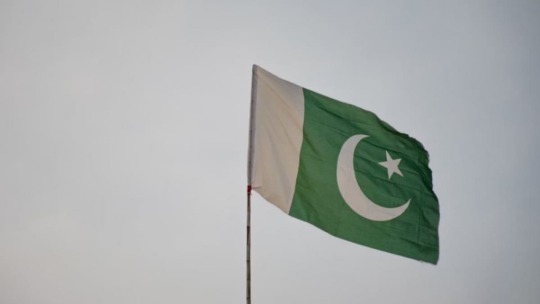
View On WordPress
0 notes
Text
Post # 140
Ralegaon Siddhi : a rags-to-riches story!
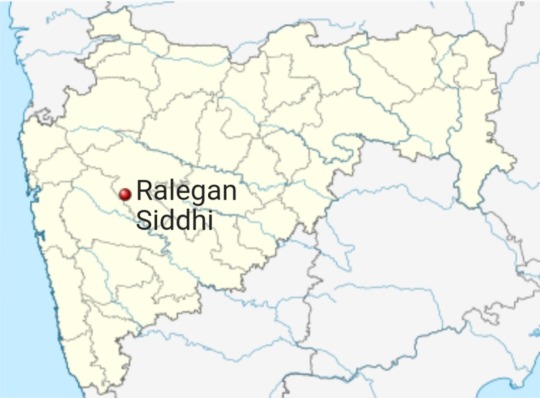
Ahmednagar, a district in central Maharashtra, contains a village housing a little under 2500 people. The village's name is Ralegaon Siddhi, also spelt as Ralegan Siddhi.
Before 1975, Ralegan Siddhi was one of the many villages of India plagued by acute poverty, over-population, drought, inadequate conservation of rain water due to soil erosion and run-off, low crop yields, low income, deprivation, neglect and hopelessness. Villagers needed to go the neighbouring village to get drinking water. Imagine that!
By 2000, 25% of its residents, i.e. about 1000 people earned over INR 5 lacs per year. Ralegan residents reportedly had private savings of INR 3 crores. Not a single villager depended on government drought relief measures. The village became so prosperous that a major bank opened its branch there. By Indian standards, Ralegan Siddhi had become a rich village.
A World Bank report endorsed that the village of Ralegaon Siddhi had transformed itself from a highly degraded village ecosystem, in a semi-arid region of extreme poverty, to one of the richest in the country. Today, this little village in West India, has become a case study of sustainable development for the entire world!
But how did this miracle happen? Therein lies a tale!
It all began, when a 38 year old, ex-army serviceman, returned to his ancestral village, Ralegaon Siddhi, in 1975, having taken voluntary retirement from the armed forces. His name is Kisan Baburao Hazare. You probably know him as Anna Hazare!
And, if the story of Anna Hazare and Ralegaon Siddhi doesn't convince you that one man can make a difference, nothing ever will.
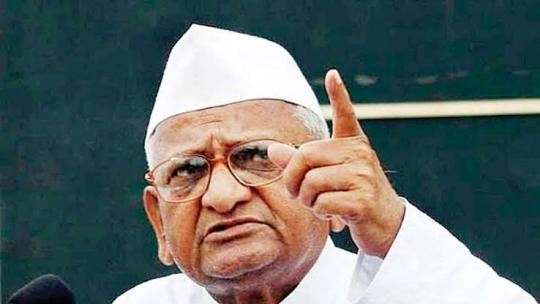
Anna Hazare grew up in Mumbai, because his village didn't have a school. He dropped out after 7th grade, because he couldn't afford to continue. He then started selling flowers in the Dadar. In time, he owned two flower shops.
When he was 23, he joined the Indian army as a truck driver. In 1965, he was posted on the Punjab border during the Indo-Pak war. The experiences of wartime, coupled with his acute poverty affected him so much that he considered suicide at one point.
One day, while driving the truck, an enemy bomb/missile struck them and Anna Hazare was the sole survivor. This experience made him ponder the meaning of life and death. He felt that God wanted him to stay alive for some reason. He decided to dedicate his life to service of mankind.
In 1975, after 15 years in the armed forces, he took voluntary retirement and went back to Ralegoan Siddhi.
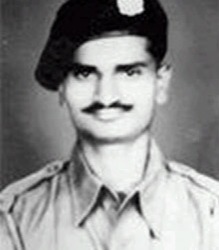
Anna Hazare returned to find Ralegoan Siddhi in a sorry state of affairs. Although most of the villagers owned some land, cultivation was extremely difficult due to the rocky ground, preventing retention of the monsoon rains. This situation was worsened by deforestation, soil-erosion and droughts. Crop yield and productivity was low, hence incomes were low and poverty was high.
One person from the village resorted to illicit liquor vending, as this seemed lucrative. His success attracted many others. Soon, the economy of the village had become reliant on the illegal manufacture and sale of alcohol, a product on which many of the villagers had become dependent. Many inhabitants borrowed from moneylenders to survive, paying monthly interest rates of as much as 10%. Crime and violence (including domestic violence) had become commonplace.
Education, health and hygiene were poor. There was only one school, upto 4th grade. Caste system and untouchability were rampant. Net-net, the scene was bad.
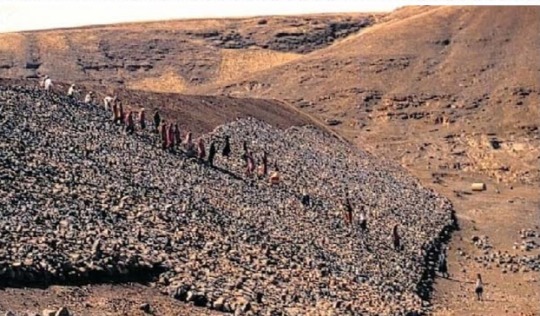
Anna Hazare had savings of INR 22000 from his provident fund and gratuity. The first task he undertook was to use INR 3000 of his funds to rebuild the decrepit Yadavbaba Temple, which was in a decrepit state. Seeing this selfless act, the village elderly felt inspired to support him and donated small amounts of money and generous amounts of free labour to construct the temple. Thus was born the concept of Shramdaan, or donating labour. Affection and respect for Anna increased.
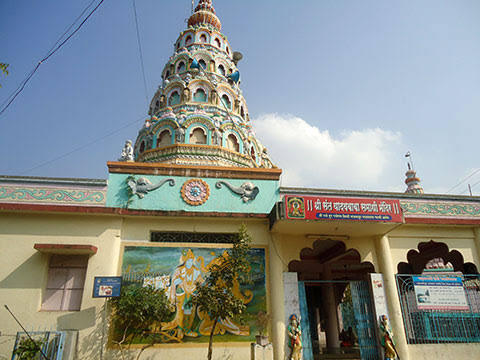
Some youth also became involved in the work and so Anna organised a Youth Association called Tarun Mandal.
Anna and Tarun Mandal then decided to take up the issue of alcoholism to drive a process of reform. At a meeting conducted in the temple, the villagers resolved to close down liquor dens and ban alcohol in the village. Since these resolutions were made in the temple, they became, in a sense, religious commitments. Over thirty liquor brewing units voluntarily closed their establishments. Those who did not succumb to social pressure were forced to close their businesses when the youth group smashed their premises. The owners could not complain as their businesses were illegal. Once three drunken villagers were tied to pillars and then flogged, personally by Anna Hazare, with his own army belt. Sale of tobacco, cigarettes and beedies were also banned. The youth group brought all the tobacco, cigarettes, and beedies from the shops in the village and burnt them in a Holi fire. Tobacco, cigarettes, or beedies are no longer sold in Ralegaon Siddhi.
In 1980, Anna Hazare started a Grain Bank at the temple. Farmers with surplus grain production would donate a quintal to the bank. In times of need, others could borrow the grain, but they had to return the amount of grain they borrowed, plus an additional quintal as an interest. This ensured that nobody in the village ever went hungry or had to borrow money to buy grain. This also prevented distress sales of grain at lower prices at harvest time.
Probably the highlight of Anna Hazare's work is the Watershed Development Programme, which has been studied and copied extensively.
Ralegan Siddhi is located in the foothills, so Anna persuaded villagers to construct watershed embankments to stop water and allow it to percolate into the ground. This increased the ground water level and improved irrigation in the area.
When Anna Hazare came to Ralegan Siddhi in 1975 only 70 acres of land was irrigated. Today, about 2,500 acres are irrigated.
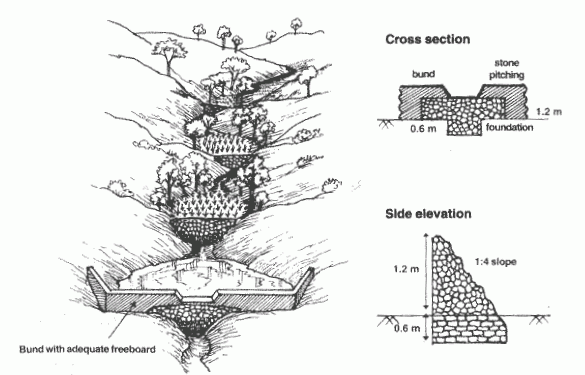
Cultivation of water-intensive crops like sugarcane was banned. Crops such as pulses, oilseeds, and certain cash crops with low water requirements replaced them. This improved yield and income.
Under Anna Hazare's moral leadership, villagers gradually decided to shun untouchability and caste discrimination. The Dalits have become integrated into the social and economic life of the village. There are examples of upper caste villagers building houses for the lower caste Dalits as a part of Shramdaan.
Today, there is a drinking water tap every 100 meters in the village.
Look at how beautiful a transformed, prosperous village looks!
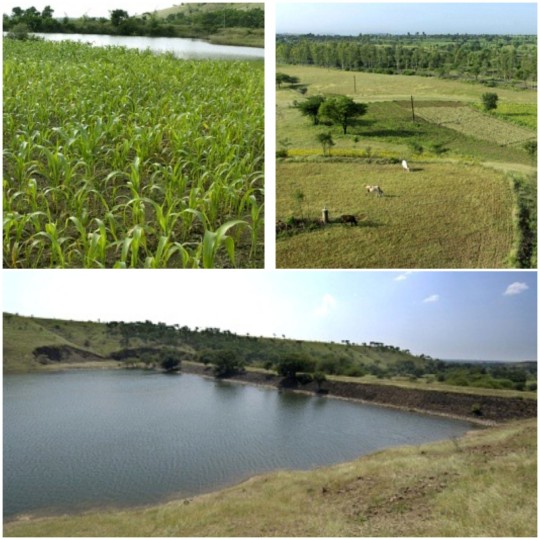
Here is a comprehensive list of all initiatives taken by Anna Hazare in Ralegaon Siddhi since he first arrived in 1975.
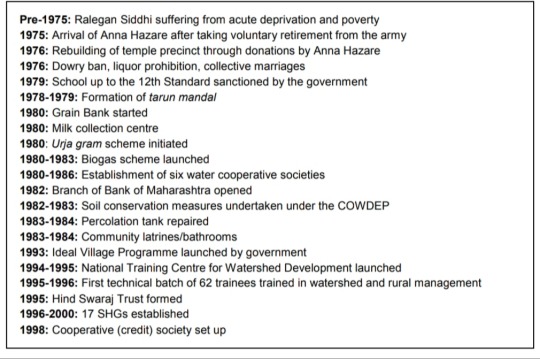
The Ralegan model owes its success to the strong value system that Anna was able to establish based on principles of sharing, compassion and equity. This value system is epitomised through the four bandis (bans) with which the villagers agreed to comply, namely – Nashabandi (ban on addiction), Nasbandi (sterilisation for population control), Kurhadbandi (ban on felling trees or deforestation) and Charaibandi (ban on grazing of cattle on green fields) and, additionally, Shramdaan.
The Government of India recognized his work by conferring the Padma Shri in 1990 and Padma Bhushan in 1992.
From 2000 onwards, Anna Hazare took his social activism to the national stage, with his movements against corruption and other forms of poor governance.
But this post remains a tribute to the grassroots - Kisan Baburao Hazare and the villagers of Ralegaon Siddhi, who took ownership of their situation and transformed themselves into a rags-to-riches story.
#anna hazare#Ralegaon Siddhi#ralegan siddhi#ahmednagar#maharashtra#kisan Baburao Hazare#indo pak war#Watershed development program#watershed#grain bank#nashabandi#nasbandi#Shramdaan#padma shri#padma bhushan
6 notes
·
View notes
Text
Pak's ex-PM Imran Khan says he tried to improve strained ties with India during his tenure
Pak’s ex-PM Imran Khan says he tried to improve strained ties with India during his tenure
Pakistan’s ousted prime minister Imran Khan on Monday said he wanted to improve strained relations with India during his tenure but the revocation of Kashmir’s special status became a “hurdle.” Lahore,UPDATED: Dec 20, 2022 04:23 IST Pakistan’s former prime minister Imran Khan. (File photo/PTI) By Press Trust of India: Pakistan’s ousted prime minister Imran Khan on Monday said he wanted to…

View On WordPress
0 notes
Text
Indian Navy Day 2022 | History And Significance Ways To Celebrate
The Indian Navy is celebrated annually on the 4th of December to highlight the contributions and accomplishments of Indian Naval forces. This day is marked and remembered for Operation Trident which was launched against Pakistan in the 1971 Indo-Pakistan War. This was a successful mission that deserves to be celebrated as the Navy played an important role in the war. Indian Navy Day is held to remember the attack and to honor all the soldiers who gave their lives in defense of the country. The Indian Navy is a three-dimensional force that defends the interests of our nation by operating above, on, and beneath the ocean's surface. Its primary goal is to make improvements to its situation in the Indian Ocean Zone. On this day, a variety of activities are held with various themes every year to honor the Indian Navy.
History And Significance
The East India Company established the Indian Navy in 1612.
Pakistan attacked Indian air sites on December 3rd, 1971, during the Indo-Pak War.
In response to that, the Indian Navy prepared an attack on the night of December 4 and 5 and Pakistan lacked the aircraft to carry out bombings at that time.
This was called Operation Trident.
During Operation Trident, the Indian Navy targeted the Pakistan Naval Headquarters in Karachi. The INS Veer, INS Nipat, and INS Nirghat missile boats as well as Vidyut-class boats were launched in the direction of Karachi, where they sank three Pakistani Navy ships, including the PNS Khaibar.
During the raid, hundreds of Pakistani Navy soldiers perished.
The Indian Navy's entire operation was under the command of Commodore Kasargod Pattanashetti Gopal Rao.
To celebrate the success of the Indian Navy and to increase awareness, Indian Navy day is celebrated on the 4th of December.
Indian Navy Day 2022 Date Importance
The date of December 4 is extremely significant because it was that day in 1971, during Operation Trident, that Indian naval forces sank four Pakistani military boats, including PNS Khaibar, killing hundreds of Pakistani soldiers.
Indian Navy Day is celebrated to honour the valiant Indian Naval Missile attack on Karachi harbour during the Indo-Pakistan war.
This day honours the naval force's magnificence, outstanding accomplishments, and contribution to the nation.
How Is Indian Navy Day Celebrated?
In remembrance of the naval attack on Karachi in the year 1971 and to honour the naval officers, Indian Navy day is celebrated grandly by bringing all the troops of the Navy together. Three commands make up the Indian Navy, the Western Naval Command, the Eastern Naval Command and the Southern Naval Command, and each is headed by a flag commander. The ships and the sailors are brought together by the Navy to celebrate. The Eastern Naval Command at Visakhapatnam also organizes a variety of activities and events with a wreath-laying ceremony at the war memorial along with a display of the naval submarines, ships, aircraft, and other forces' capabilities.
Know More About Indian Navy Day
Every year, Navy Day is celebrated with contests like Navy Ball and Navy Queen along with a Navy Fest.
On this day, visitors, including schoolchildren, are welcome to tour the warships and planes of the Indian Navy.
The President of India serves as the Supreme Commander of the Indian Navy.
During Operation Trident, the Indian Navy struck Karachi on the evening of December 4, 1971. Anti-ship missiles were used for the first time in this operation.
Shivaji, the Maratha Emperor, is regarded as the "Father of the Indian Navy"
Blood camps are also conducted throughout the country on the Indian Navy day.
Conclusion
The Indian Navy plays a crucial part in defending the nation's maritime borders as well as in fostering better foreign ties in India through port visits, financial investments, disaster assistance, and many other activities. It is one of the strongest naval forces in the world. To honour the soldiers of the naval army the day of Operation Trident is chosen, as it is one of the best days in the history of the Indian Navy that marked a significant impact in the Indo-Pak war. Celebrate Indian Navy Day on the 4th of December to honour and respect your brothers and sisters in the Indian Navy.
0 notes
Text
How to buy Indian Delicious sweets and snacks online?
Sweets and Snacks are everybody’s favourite, ranging from a kid to older people. Did your mouth drool after hearing these words? Surely, it did. Well, Indian sweets and snacks have their special place in the world due to their taste. Everyone loves to eat them, they are being bought for every occasion, every festival, every special day. Exchanging sweets and sacks is a gesture made by friends and families to cherish and deliver the good news. There are plenty of different sweets and snacks made in larger quantities each day in India and every state has its flavour and taste. They are of great use because when you have to provide your guests you can provide them with instant ready snacks and sweets. Are you someone who lives outside India and wants to have Indian sweets and snacks that takes just like home but has no idea where to? This blog will help you get to know the best platform to buy sweets and snacks online from the Indian grocery store in the USA. There is no more homesickness but you will now be delivered with every Indian food item that you require right at your doorstep. So, let us not waste more time knowing about the guide to buying Indian delicious sweets or snacks online and where to buy it.

Best Platform to buy sweets and snacks online
The only struggle is to find a better place to buy Indian groceries online but now that struggle has also come to an end. It is because you have the best Indian grocery shopping platform available to you. Buniyaa is a small e-commerce business platform that provides you with Indian groceries and essentials. We initiated this platform in the year 2015 and now successfully established a great relationship with our customers by serving them with supreme quality products at the optimum deals. All kinds of sweets and snacks are available here, so buy from our online grocery store in the USA. We have always strived on serving better and accept feedback to look out for the areas that need improvement if any.
Best quality products are available at the lowest prices available so the needs of every section can be catered to.
Have a reliable source of suppliers and knowledge of the spice trade.
100% protected and organic, with no added preservatives and flavours. As a result of this, you nowhere compromise with the quality and taste.
Saves you a lot of time and parking issues, because everything you need is now delivered to your doorstep only.
Sweets and snacks available here are not only tasty but healthy as well in all aspects.
Have expertise in handling USDA and US FDA issues.
Have a safe and secure checkout payment method, so you face no authenticity or reliability issues.
Every Indian grocery item is available here ranging from basic to exclusive.
Types of Sweets and Snacks Available on Buniyaa
Our brand has ties with multiple brands and sources products from different countries like India, Indonesia, Spain and several other countries. You will find a variety of sweets and snacks which you can buy online from our Indian grocery store. There are plenty of items available there but a few of them are:
Snacks
Biscuits like Parle-G, McVitie’s Digestive Wheat biscuits, Monaco, Krackjack butter masala, Pele Nice, Hide & Seek Chocolate chip cookies and many more. Different chips like Lays Magic Masala, Salted Indian style, Uncle chips spicy treats, Monaco Jeffs Jeera, Aara Corn, Aara Pha thick, Chaakri breakfast Khakhra, Aara Fryums, and much more. They are healthier and even tastier than can be consumed anytime you want to. All the varieties and different flavours are available in the biscuits category. These are all quick Indian snacks available on our online Indian grocery store in the USA.
Sweets
Aara Peanut Pak, Parle choco rolls, GRB Soan Papdi, Rusks, GRB Pineapple Soan Papdi, Different sweet candies, GRB Rasogolla, GRB Gulab Jamun, Pineapple Halwa, Dry Fruit Halwa, Amul Rasogolla, Kesar Malai peda, Assorted Katlis, Motichoor Ladoo, Sangeeta sweet premium mix, Butterscotch ladoo and much more. These are just a few but the abundance of sweets like these are available here. These sweets are made from pure desi ghee that states just like home and the varieties available here will not be found anywhere else. After having it once, you will crave it more and more.
Patanjali Snacks
Patanjali snacks like patanjali bel candy, patanjali pachak methi nimbu, patanjali pachak hing peda, Patanjali Gulkand, Amla candy, Pachak Ajwain, Hig Goli, Anardana Goli, etc. Patanjali snacks and sweets are not only tasty and healthier but also possess medicinal properties that cure multiple problems and give you a healthier life.
Conclusion
Buying sweets and snacks from Buniyaa is the best option for people living in the USA because not only do they provide you with healthier and organic Indian grocery items but also provide you with the optimum deals you will find nowhere else.
0 notes
Text
PM Imran invites Saudi companies, entrepreneurs to benefit from Pakistan’s huge investment potential

Prime Minister Imran Khan on Monday urged the Saudi companies and entrepreneurs to benefit from Pakistan’s strategic location as well huge investment potential in diverse areas of economy including housing and construction for mutual benefit.
He particularly mentioned the mega development projects of Ravi City and Central Business District in Lahore and said it was the right time for Saudi investors to benefit from these projects.
The Prime Minister was addressing the Saudi-Pak Investment Forum organized in cooperation with Saudi Ministry of Investment.
The Investment Forum was attended by senior representatives of the leading Saudi companies and entrepreneurs as well as Pakistani businessmen.
Besides Saudi Investment Minister Engr. Khalid Al-Falih, the Forum was also addressed by Foreign Minister Shah Mahmood Qureshi, Advisor on Finance Shaukat Tarin and Energy Minister Hammad Azhar.
Prime Minister Imran Khan highlighting the close and historic ties between the two brotherly nations said that Pakistan-Saudi relations transcend all other relations due to people to people contacts. Whichever government comes to power in Pakistan, it does not affect Pakistan-Saudi relations, he added. The Prime Minister said the special relationship with Saudi Arabia besides the fact that they were tied with the two Holy Mosques, Pakistan and Saudi Arabia always stood with each other in hard times. “As human beings, we don’t remember those who were with you in good times but those who stood with you in bad times”, he remarked. Reiterating his country’s commitment to the territorial integrity of the Kingdom, the Prime Minister said that whenever there is any security threat, Pakistan will stand with Saudi Arabia and ensure its security.
Imran Khan said like Crown Prince Mohammad bin Salman bin Abdulaziz, who has dynamism and a pashion for change, he also wanted a Naya Pakistan. He said that Pakistan was the fastest growing economy in Asia until 1960s with strong institutions like PIA being one of the best airlines in the world at that time. “Then we lost that path through the policy of nationalisation”, he added. The Prime Minister said that now the present government was exploring the potential by incentivising various sectors in a country of 220 million people, out of which majority of people were below the age of 30 years. He said that Pakistan due to its strategic location having two biggest markets in the neighbourhood and connectivity with Central Asia through Afghanistan priveded a real opportunity to investors to take benefit. The Prime Minister said that if relations with India are improved, which was possible only through the resolution of Jammu and Kashmir dispute in line with the UN Resolutions and giving the Kashmirs right of self-determination, Pakistan will have access to three big markets. Urging the Saudi companies to benefit from Pakistan’s potential and opportunitiesm, he said that it was right time for them in invest in two mega projects of Ravi Urban City and Central Business District in Lahore. “If you look at the strategic location of Pakistan, which is open for investment, it can benefit both Saudi Arabia and Pakistan””, he added. Similarly, the Prime Minister said that with 300,000 acres of virgin land – next to River Indus, allocated for investment, Saudi companies can invest in agriculture and food security sectors. “If we come together, it will really benefit the two countries,” he stressed. Foreign Minister Shah Mahmood Qureshi focused on Pakistan’s shift from geo-politics to geo-economics; Adviser on Finance highlighted economic resurgence of Pakistan; and Minister for Energy outlined the vast opportunities in the energy, agriculture, livestock and other key sectors. The Saudi Minister for Investment, in his keynote address, underscored the longstanding and abiding ties between Saudi Arabia and Pakistan and reaffirmed the resolve to further deepen bilateral trade, investment and business links.
https://ift.tt/3CrLA2V
0 notes
Text
Afghanistan crisis live updates august 21, 2021
Afghanistan crisis live updates august 21, 2021
The UN food agency says it has been able to negotiate access with the Taliban to distribute aid in one provincial capital in Afghanistan but hasn’t been able to resume food deliveries to three other provincial capitals it supplies.
Worldview with Suhasini Haidar | Taliban advance in Afghanistan
The World Food Program, headquartered in Rome, has said that some 14 million people are facing severe hunger in the nation of some 39 million. A second drought in three years, combined with fighting, had afflicted Afghanistan even before the Taliban takeover of the country on Sunday.
Here are the latest developments:
Taliban co-founder Baradar in Kabul for talks to set up government
Taliban co-founder Mullah Abdul Ghani Baradar arrived in Kabul for talks on establishing a new “inclusive” government in Afghanistan, a senior official said.
Other senior Taliban leaders seen in the capital in recent days include Khalil Haqqani — one of America’s most wanted terrorists with a $5 million bounty on his head.
Pro-Taliban social media feeds showed Haqqani meeting Gulbuddin Hekmatyar — a former bitter rival during the brutal civil war of the early 1990s, but still influential in Afghan politics.
A senior Taliban official told AFP that Baradar would meet “jihadi leaders and politicians for an inclusive government set-up”. — AFP
India evacuates around 80 people from Kabul
Around 80 Indian nationals were evacuated on Augst 21 from Kabul by a transport military aircraft of the Indian Air Force (IAF) amid a deteriorating security scenario in the Afghan capital, people familiar with the development said.
The aircraft landed at Dushanbe in Tajikistan after evacuating the Indians, they said, adding the flight is expected to arrive at the Hindon airbase near Delhi in the evening.
As per a rough estimate, the number of Indians stranded in Afghanistan could be around 400 and India has been looking at ways to evacuate them, including by coordinating with the U.S. and other friendly countries. — PTI
Taiwan says China wants to ’emulate’ the Taliban
Taiwan’s foreign minister accused China on August 21 of wanting to “emulate” the Taliban, saying the island that Beijing claims as sovereign Chinese territory did not wish to be subject to communism or crimes against humanity.
The rapid fall of the U.S.-backed Afghan government has sparked heated debate in Taiwan about whether they could suffer the same fate to a Chinese invasion, while state media in China has said Kabul’s fate showed Taiwan it cannot trust Washington. -REUTERS
Bahrain says allows airport use for evacuations
The island kingdom of Bahrain has said it is “allowing flights to make use of Bahrain’s transit facilities” amid the evacuations of Afghanistan.
The kingdom made the announcement in a statement released early August 21.
Bahrain, in the Persian Gulf off Saudi Arabia, is home to the U.S. Navy’s 5th Fleet.
The announcement comes as the U.S. faced issues August 20 with its facilities at Al-Udeid Air Base in Qatar filling up with those fleeing the Taliban takeover of the country. –AP
President Biden warns lives could be lost in massive Kabul airlift operations
U.S. President Joe Biden has said that the mass evacuation from Kabul, one of the largest and most difficult airlifts in history, is not without risk of loss of lives, but vowed to bring all Americans and partners home from Afghanistan, as his administration grappled with the fallout from the chaotic exit.
Mr. Biden’s remarks on August 20 come as the U..S rushed to airlift as many people as possible out of the Afghan capital ahead of a self-imposed deadline to depart Afghanistan by August 31.
In a speech delivered from the White House, Mr. Biden said the United States has evacuated more than 18,000 people since July and approximately 13,000 since the airlifts began on Saturday.
NATO commits to improving operations at Kabul airport
An evacuee holds up a peace sign after being manifested for a flight at Hamid Karzai International Airport, in Kabul. | Photo Credit: REUTERS
NATO foreign ministers committed on August 20 to focus on ensuring the safe evacuation from Afghanistan of their citizens and of Afghans deemed at risk after the Taliban takeover, centering on improving operations at Kabul airport first.
Faced with continuing chaos in the capital and the exit roads, many of the 30 allied nations raised “the need to work harder on how we can get more people … into the airport, then processed and then onto the planes,” NATO Secretary General Jens Stoltenberg said. He called that “the big, big, big challenge.”
All too often over the past hours and days, planes from NATO nations have been able to get to Kabul, only to be forced to leave empty or near-empty.
Blinken says 12 nations to host Afghan evacuees
Secretary of State Antony Blinken says 13 countries have thus far agreed to at least temporarily host at-risk Afghans evacuated from Afghanistan and a dozen more have agreed to serve as transit points for evacuees, including Americans and others.
Mr. Blinken says in a Friday statement that potential Afghan refugees not already cleared for resettlement in the United States will be housed at facilities in Albania, Canada, Colombia, Costa Rica, Chile, Kosovo, North Macedonia, Mexico, Poland, Qatar, Rwanda, Ukraine and Uganda.
Transit countries include Bahrain, Britain, Denmark, Germany, Italy, Kazakhstan, Kuwait, Qatar, Tajikistan, Turkey, the United Arab Emirates and Uzbekistan. -PTI
Taliban to unveil new Afghan govt framework within weeks, official says
The Taliban aim to unveil a new governing framework for Afghanistan in the next few weeks, a spokesman for the Islamist movement said on August 21, after the insurgents’ swift takeover of the South Asian nation.
“Legal, religious and foreign policy experts in the Taliban aim to present the new governing framework in the next few weeks,” the official told Reuters. –Reuters
U.S. is going to retain laser focus on its counterterrorism mission in Afghanistan: Biden
The United States is going to retain a laser focus on its counterterrorism mission in Afghanistan, President Joe Biden said August 20 and warned the Taliban of a forceful response to any attack on American forces or disruption of its operations at the Kabul airport.
“We made clear to the Taliban that any attack, any attack on our forces or disruption of our operations at the airport will be met with a swift and forceful response,” Mr. Biden told reporters at a White House news conference.
“We’re also keeping a close watch on any potential terrorist threat at or around the airport, including from the ISIS affiliates in Afghanistan,” he said. –PTI
LGBT+ Afghans desperate to escape amid Taliban takeover
It was never easy being gay or transgender in Afghanistan. Now it could be deadly, according to LGBT+ Afghans, whose fear of violence under the Taliban is driving a frantic bid to escape.
But how any evacuation might work is another matter, with scant practical support coming from overseas and even less hope that Islamist militants will let them into the airport.
“If I find a visa and a country gives me permission to leave, of course I will risk everything to get out,” said one gay Afghan student, whose name was withheld for his protection. –Reuters
Pak’s strategic interest in Afghan is to counter Indian influence, mitigate spillover: U.S. State Dept IG
Pakistan’s strategic security objectives in Afghanistan almost certainly continue to be countering Indian influence and mitigating spillover of the Afghan civil war into Pakistani territory, a U.S. government report has said, citing inputs from the Defence Intelligence Agency.
“Pakistan continues to support peace talks, while maintaining ties with the Afghan Taliban,” U.S. Department of State Office of the Inspector General noted in its latest quarterly report on Afghanistan.
“According to the DIA, Pakistan’s strategic security objectives in Afghanistan almost certainly continue to be countering Indian influence and mitigating spillover into the Pakistani territory,” the report said. –PTI
India to prioritise granting visas to civil society members, opinion makers, women activists from Afghanistan
In line with its historical ties with Afghan people, India will prioritise granting visas to civil society members, opinion makers, women activists, students and NGO workers from Afghanistan in view of the current situation in the country, people familiar with the development said on August 20.
Afghan people feeling threatened or facing the fear of persecution and those who supported India in rolling out various welfare and development projects will also be given priority for grant of visas, they said. –PTI
Taliban appeals for international recognition; says China has ‘big role’ to play
The Taliban have appealed to the international community to recognise it amid growing resentment against it at home and abroad, even as the Afghan militant group sought to placate China, saying Beijing can play a “big role” under its rule in the strife-torn country.
Taliban spokesman Suhail Shaheen said the international community should “respect the will of the Afghan people” and officially recognise his group which has taken over power in Kabul. –PTI
Hunger spreading in Afghanistan: UN food agency
Andrew Patterson, WFP’s deputy country director, told The Associated Press on Friday that after Faizabad, a provincial capital in the north, fell to the Taliban last week, the agency’s field office succeeded in negotiating access with the local Taliban command, and “we had (a food) truck on the road the next day.” However, Patterson said the situation in Kandahar, Herat and Jalalabad so far hasn’t allowed the U.N. agency to resume distributing food in those areas.
Biden vows to evacuate all Americans
President Joe Biden pledged firmly Friday to bring all Americans home from Afghanistan — and all Afghans who aided the war effort, too — as officials confirmed that U.S. military helicopters flew beyond the Kabul airport to scoop up 169 Americans seeking to evacuate. Biden’s promises came as thousands more Americans and others seeking to escape the Taliban struggled to get past crushing crowds, Taliban airport checkpoints and sometimes-insurmountable U.S. bureaucracy.
“We will get you home,” Biden promised Americans who were still in Afghanistan days after the Taliban retook control of Kabul, ending a two-decade war. The President’s comments, delivered at the White House, were intended to project purpose and stability at the conclusion of a week during which images from Afghanistan more often suggested chaos, especially at the airport.
“We’re making the same commitment” to Afghan wartime helpers as to U.S. citizens, Biden said, offering the prospect of assistance to Afghans who largely have been fighting individual battles to get the documents and passage into the airport that they need to leave. He called the Afghan allies “equally important” in the evacuations. –AP
Online petition seeking asylum for Afghan women gets 3 lakh signatures
Adeeba Qayoumi, a 21-year-old woman who fled to India from Herat, Afghanistan, in 2019, has started an online petition in memory of her 29-year-old cousin Farishta — a civil rights activist killed by the Taliban last year.
As of Friday evening, the online petition, which urges the Central government to grant asylum to women and children who are fleeing Afghanistan, had received over three lakh signatures.
Official Taliban websites go offline
Taliban websites that delivered the insurgents’ official messages of victory to Afghans and the world at large in five languages went offline abruptly on August 20, indicating an effort to squelch them.
It is not immediately clear, though, why the sites in the Pashto, Urdu, Arabic, English and Dari languages went offline. They had been shielded by Cloudflare, a San Francisco-based content delivery network and denial-of-service protection provider.
Indonesia evacuates dozens
Indonesia has moved its Afghanistan diplomatic mission from Kabul to Pakistan, its foreign minister said on Saturday, after its air force evacuated dozens in the wake of the Taliban’s seizure of power.
“Temporarily, the diplomatic mission in Kabul will be done from Islamabad,” Retno Marsudi said in televised remarks at the Halim military airport in Jakarta.
The initial plan had been to “continue our diplomatic mission in Kabul with a small team” but changed due to a “new development”, which she did not specify. She did not take questions.
The Kabul airport has been the site of chaos https://www.reuters.com/world/asia-pacific/nato-pledges-speed-evacuations-afghanistan-criticism-mounts-2021-08-20 in recent days, with thousands of desperate Afghans trying to flee as they clutched papers, children and belongings, as people from other countries also sought to leave after U.S. and other foreign troops withdrew. At least 12 people have been killed since the Islamist. –Reuters
(With inputs from agencies and our Correspondents)
. Source link
0 notes
Link
World leaders congratulate US President Biden Joe Biden has said he will heal the nation after four years of tumult. — AFP PARIS: World leaders said they were looking forward to working with US Joe Biden, as the Democrat was sworn in as president after four turbulent years under Donald Trump. Pakistan Prime Minister Imran Khan congratulated US President Joe Biden on his inauguration and said he looks forward to building stronger US-Pak ties. “I congratulate President JoeBiden on his inauguration. Look forward to working with POTUS in building a stronger Pak-US partnership through trade and economic engagement, countering climate change, improving public health, combating corruption and promoting peace in region and beyond,” the prime minister wrote in a message on Twitter. European Union Charles Michel, president of the European Council, tweeted congratulations to both Biden and Vice President Kamala Harris, adding: “It’s time to bring back conviction & common sense and rejuvenate our EU-US relationship.” European Commission President Ursula von der Leyen said: “Europe is ready for a fresh start.” Iran President Hassan Rouhani hailed the departure of “tyrant” Trump, Tehran having repeatedly called on Washington to lift sanctions imposed over its nuclear drive. “We expect (the Biden administration) to return to law and to commitments, and try in the next four years, if they can, to remove the stains of the past four years,” said Rouhani. Biden’s administration wants the United States back in the landmark Iran nuclear accord, from which Trump withdrew, provided Tehran returns to strict compliance. Israel Prime Minister Benjamin Netanyahu urged Biden to “strengthen,” a long-standing alliance between the two countries. “I look forward to working with you to further strengthen the US-Israel alliance, to continue expanding peace between Israel and the Arab world and to confront common challenges, chief among them the threat posed by Iran,” Netanyahu said in a video. NATO “The bond between North America and Europe is the bedrock of our security, and a strong NATO is good for both North America and Europe,” said NATO General Secretary Jens Stoltenberg. “NATO Allies need to stand together to address the security consequences of the rise of China, the threat of terrorism, including in Afghanistan and Iraq, and a more assertive Russia.” The Vatican Pope Francis urged Biden to promote “reconciliation and peace” around the world. “At a time when the grave crises facing our human family call for far-sighted and united responses, I pray that your decisions will be guided by a concern for building a society marked by authentic justice and freedom,” the pope said. Russia Kremlin spokesman Dmitry Peskov said Russia would seek “good relations with the United States”, while a foreign ministry statement said they expected a “more constructive” approach to upcoming arms control talks. The US and Russia are to discuss extending the landmark 2010 New START nuclear weapons accord shortly after Biden’s swearing in. The last remaining nuclear pact between the countries, it limits each side to 1,500 nuclear warheads and is set to expire February 5. Germany President Frank-Walter Steinmeier of Germany, Europe’s biggest economy, said he was “greatly relieved” Biden was replacing Trump as US president, calling it a “good day for democracy”. Germany looked forward “to knowing we again have the US at our side as an indispensable partner” in addressing “the coronavirus pandemic, climate change, security issues, arms control and disarmament, and many urgent conflicts around the world”. France French government spokesman Gabriel Attal said Biden’s commitments to rejoin the World Health Organization, which leads the global response to the Covid-19 pandemic, and the Paris climate treaty were “extremely important” following Trump’s exit from them. Britain Prime Minister Boris Johnson, who has faced criticism over his close relationship with Trump, said he was looking forward to “working closely” with Biden. “In our fight against Covid and across climate change, defence, security and in promoting and defending democracy, our goals are the same and our nations will work hand in hand to achieve them,” he said. Ireland “Today a true friend of Ireland @JoeBiden became the 46th President of the USA,” Prime Minister Micheal Martin wrote on Twitter. “It is a day of history and hope and I look forward to forging ever closer ties between our two great nations.” Canada “Our two countries are more than neighbours – we are close friends, partners, and allies,” Prime Minister Justin Trudeau said, pledging Canada’s cooperation in fighting the coronavirus pandemic, for climate action and for a sustainable economic recovery. India Indian Prime Minister Narenda Modi tweeted: “My warmest congratulations to @JoeBiden on his assumption of office as President of the United States of America. I look forward to working with him to strengthen India-US strategic partnership.” https://timespakistan.com/world-leaders-congratulate-us-president-biden/11025/
0 notes
Text
NCERT Class 12 Political Science (World) Chapter 5 Contemporary South Asia
NCERT Class 12 Political Science Solutions (Contemporary World Politics)
Chapter 5 Contemporary South Asia
TEXTBOOK QUESTIONS SOLVED : Q 1. Identify the country: (a) The struggle among pro-monarchy, pro-democracy groups and extremists created an atmosphere of political instability. (b) A landlocked country with multi¬party competition. (c) The first country to liberalise the economy in the South Asian region. (d) In the conflict between the military and pro-democracy groups, the military has prevailed over democracy. (e) Centrally located and shares borders with most of the South Asian Countries. (f) Earlier the island had the Sultans as the head of state. Now, it is a republic. (g) Small savings and credit cooperatives in the rural areas have helped in reducing poverty. ( h ) A landlocked country with a monarchy.
Answer: (a) Nepal (b) Bhutan (c) India (d) Pakistan (e) India (f) Maldives (g) India (h) Nepal Q 2. Which among the following statements about South Asia is wrong? (a) All the countries in South Asia are democratic. (b) Bangladesh and India have signed an agreement on river-water sharing. (c) SAFTA was signed at the 12th SAARC Summit in South Asian politics. (d) The US and China play an influential role in South Asian politics.
Answer: (a) All the countries in South Asia are democratic. Q 3. What are some of the commonalities and differences between Bangladesh and Pakistan in their democratic experiences?
Answer: Bangladesh has been the part of Pakistan itself. Both of these countries bear some similarities and differences as follows: Commonalities 1. Both Bangladesh and Pakistan were under a military rule. 2. At both the places, the struggle for democracy took place in their own way. 3. Pakistan’s administration began under the command of General Ayub Khan and gave up due to dissatisfaction among people giving way to Yahya’s military rule and continued with the army rule though elections were held by military rulers to give a democratic shape to their own rule. 4. In the same way, Bangladesh drafted its own constitution to begin with democracy. Sheikh Mujibur Rahman formed presidential setup by abolishing all the parties except Awami Legue. But after his assassination the new military ruler Zia-ur-Rahman formed his own party and won elections in 1979. Later on he was also assassinated and another military leader Lt. Gen. H.M. Ershad took over. Differences 1. In Pakistan, military, clergy and land-owning aristocrats dominated socially to overthrow elected government whereas in Bangladesh the leaders and their party members dominated for the same. 2. Pro-military groups have become more powerful due to conflict with India in Pakistan whereas in Bangladesh, pro-military groups are powerful due to friendship and encouragement of India. Q 4. List three challenges to democracy in Nepal.
Answer: The three challenges to democracy in Nepal were the result of a triangular conflict between- 1. the monarchist forces 2. the democrats 3. the Maoists These challenges created massive, countrywide, pro-democracy protest in April 2006. Q 5. Name the principal players in the ethnic conflict in Sri Lanka. How do you assess the prospects of the resolution of this conflict?
Answer: The principal players in the ethnic conflict in Sri Lanka were Sinhala and Sri Lankan Tamils. After its independence, politics in Sri Lanka was dominated by the interests of Sinhala community who was hostile to Tamils, who migrated from India to be settled there. Sinhalese presumed Sri Lanka to be belonged to them only, hence no concession should be given to Tamils. This created militant Tamil nationalism i. e. ‘Ethnic conflict’. Despite the revenges of internal conflict Sri Lanka has maintained democratic political system and registered considerable economic growth and high level of human development. Q 6. Mention some of the recent agreements between India and Pakistan. Can we be sure that the two countries are well in their way to a friendly relationship?
Answer: Although Indo-Pakistan relations seem to be the story of endemic conflict and violence, there have been a series of efforts to manage tensions and build peace under the various agreements: 1. Agreed to undertake confidence building measures to reduce the risk of war. 2. Social activists and prominent personalities have collaborated to create an atmosphere of friendship. 3. Leaders have met at summits to better understanding. 4. Bus routes have been opened up between these two countries. 5. Trade between the two parts of Punjab has increased substantially in the last five years. 6. Visas have been given more easily. No, despite the above mentioned agreements and initiatives, we can not be sure that both the countries are well in their way to friendship, still some areas of conflict exist there to be sorted out, Q 7. Mention two areas each of cooperation and disagreement between India and Bangladesh.
Answer: Disagreement 1. Differences over the sharing of the Ganga and Brahmaputra river waters. 2. Illegal immigration to India. 3. Refusal to allow Indian troops to move through its territory. 4. Not to export natural gas to India. Cooperation 1. Economic relations have been improved considerably within last ten years. 2. Bangladesh is the part of India’s ‘Look East’ policy to link up with southeast Asia via Myanmar. 3. Cooperated on the issues of disaster management and environment. 4. Cooperation on identifying common threats and being more sensitive to each other’s needs. Q 8. How are the external powers influencing bilateral relations in South Asia? Take any one example to illustrate your point.
Answer: The external powers influence bilateral relations in South Asia because no region exists in the vacuum. It is influenced by outside powers and events no matter how much it may try to insulate itself from non-regional powers: 1. China and the US remain key players in South Asian politics. 2. Sino-Indian relations have improved significantly in the last ten years, but China’s strategic partnership with Pakistan remains a major irritant. 3. The demands of development and globalisation have brought the two Asian giants closer and their economic ties have multiplied rapidly since 1991. 4. The US enjoys good relations with both India and Pakistan and works as a moderator in Indo-Pak relations. 5. Economic reforms and liberal economic policies in both the countries have increased the depth of American participation. . _ 6. The large South Asian economy remains in the US and the huge size of population and markets of the region give America an added stake in the future of regional security and peace. Q 9. Write a short note on the role and the limitations of SAARC as a forum for facilitating economic cooperation among the South Asian Countries.
Answer: Role of SAARC: Role of SAARC can be identified as follows: 1. ‘South Asian Association for Regional Co-operation’ (SAARC) is a regional initiative among South Asian states to evolve cooperation since 1985 onwards. 2. It consists of seven members to encourage mutual harmony and understanding. 3. SAARC has initiated SAFTA (South Asian Free Trade Agreement) to free trade zones for wThole south Asia for collective economic security. 4. SAARC has projected on economic development of its member states to reduce their dependencies on the non-regional powers. Limitations: SAARC is growing slowly due to political differences among its member states— 1. Only the conflicts led to bilateral issues as Kashmir problem between India and Pak. 2. Some of the India’s neighbours fear that India intends to dominate them by influencing their societies and politics. 3. SAARC members are from among the developing or least developing countries which creates insufficiency of funds. Q 10. India’s neighbours often think that the Indian government tries to dominate and interfere in the domestic affairs of the smaller countries of the region. Is this a correct impression?
Answer: No, the impression is not correct because India makes efforts to manage its neighbours beyond its size and powers which can be justified on following grounds- 1. India often feels exploited by its neighbours. 2. On the other hand, India’s neighbours fear that India wants to dominate them regionally but India is centrally located who shares borders with other countries geographically, which should be accepted on mutual understanding. 3. India avoids political instability in its neighbouring states so that outsiders should not take advantage of influence in the region.
MORE QUESTIONS SOLVED
Very Short Answer Type Questions [1 Mark] Q 1. Fill in the blanks: The South Asian Free Trade Agreement (SAFTA) was signed by the members of in the year
Ans: SAARC, 2004. Q 2. Whose mediation resolved the Indus River water dispute between India and Pakistan?
Answer: The World Bank. Q 3. How long did East and West Pakistan remain together?
Answer: From 1947 to 1971. Q 4. What was the reason for the formation of SAARC?
Answer: The states of South Asia recognised cooperation and friendly relations among themselves which gave birth to the formation of SAARC for mutual trust and understanding among its member states. Q 5. What is the full form of SAARC?
Answer: SAARC: South Asian Association for Regional Co-operation. Q 6. Mention present status of Sri Lanka.
Answer: Sri Lanka has maintained a democratic political system alongwith a considerable economic growth i.e. Sri Lanka is one of the first developing countries to control population growth rate, liberalised economy and bears highest per capita Gross Domestic Product despite ongoing conflicts. Q 7. What does the MDP stand for?
Answer: MDP stands for Maldivian Democratic Party. Q 8. Who took the command over Pakistan after its first constitution was framed?
Answer: General Ayub Khan. Q 9. What does SPA stand for?
Answer: SPA stands for Seven Party Alliance to protest against monarchy in Nepal. Q 10. What was the former name of Sri Lanka?
Answer: Ceylon. Q 11. Mention changes that occurred in Maldives.
Answer: 1. Transformed into a republic with a presidential form of government in 1968. 2. In June 2005, parliament voted unanimously to introduce multi¬party system. 3. Democracy strengthened after 2005 elections. Q 12. What is meant by Geo-politics?
Answer: Geo-politics refers togetherness of countries who are bound with each other geographically and their interests are also interlinked politically and economically. Q 13. What do you mean by South Asia?
Answer: South Asia signifies a group of seven countries i.e. Bangladesh, Bhutan, India, Nepal, Sri Lanka, Pakistan and the Maldives who stand for diversity in every sense but still constitute one geo¬political space. Q 14. How did LTTE emerge?
Answer: LTTE emerged 1983 onwards on the negligence of Tamil interest by Sri Lanka government. Hence, ‘Liberation Tigers of Tamil Elam’ (LTTE) took birth demanding a seperate state for Tamil in Sri Lanka. Q 15. What does SAFTA stand for?
Answer: SAFTA: South Asian Free Trade Area Agreement.
Very Short Answer Type Questions [2 Marks]
Q 1. Mention the names of member states of SAARC.
Answer: India, Bangladesh, Bhutan, Nepal, Sri Lanka, Pakistan and Maldives. Q 2. Mention any two objectives of SAARC.
Answer: 1. To provide an integrated programme for regional development. 2. To accelerate economic growth, social progress in the region. Q 3. “Democracy in South Asia has expanded the global imagination of democracy”. Do you agree? Justify.
Answer: The various countries in South Asia have experienced mixed record of democracies and the people also share an aspiration for democracy to be flourished not only in rich or developed countries but in developing and underdeveloped countries also which can be drawn from the examples of Nepal, Pakistan, Bangladesh, Bhutan and Maldives, because— 1. Every ordinary citizen, rich or poor belonging to different religions view the idea of democracy positively and support the institutions of representative democracy. 2. They prefer democracy over any other form of democracy and think that democracy is suitable for their country. Q 4. Explain the problems that India have with Pakistan.
Answer: India have following problems with Pakistan: 1. The problem of Kashmir on the issues of Pak occupied Kashmir (Pok) and Line of Control (LOC). India claims Kashmir to be its integral part and Pakistan refuses to accept it. Hence, wars took place in 1965 and 1971, but issue remained unsettled. 2. Problems over starting issues like control of Siachin glacier and over acquisition of arms involved both the states acquiring nuclear weapons and missiles to deliver such arms against each other in 1990s. 3. Pakistan government has been blamed for using a strategy of low key violence by helping Kashmiri militants with arms, training, money and protection to carry out terrorist strikes against India. 4. Pak’s spy agency Inter Services Intelligence (ISI) is alleged to involve in various anti India campaigns. Q 5. “Military rule and democracy are the two sides of a coin in Pakistan”. Examine the statement.
Answer: Military rule and democracy co-exist or are the two sides of a coin can be examined with the following facts: 1. After the implementation of first constitution in Pakistan, General Ayub Khan took the command, but was overthrown by military general Yahya Khan due to dissatisfaction of rule. 2. Again in 1971, Zulfikar Ali Bhutto formed an elected government which was later removed by General Zia-ul- Haq in 1977. 3. 1982 onwards, pro-democracy movements took place resulting an elected democratic government in 1988 under leadership of Benazir Bhutto, replaced by Nawaz Sharif. 4. Nawaz Sharif was again removed by General Pervez Musharraf in 1999 and in 2005, he got himself elected as president but was later dethroned by the court. Q 6. What is Indus River Water Treaty? Mention its significance also.
Answer: India and Pakistan signed Indus River Water Treaty by the mediation of the world bank in 1960 over the issue of sharing of rivers of the Indus basin. This treaty has been survived despite many military conflicts between these two countries. . Q 7. Why did India help Bangladesh to get independence and how?
Answer: Bangladesh was created by the support of India because: 1. West Pakistan did not allow Awami League, an East Pakistani Party to form government despite winning all the seats. 2. East Pakistanis rebelled against and were suppressed by the army of West Pakistan, resulting large scale migration into India. 3. This created huge refugee problem for India. 4. Hence, India supported the demand of East Pakistanis financially and militarily. 5. In December 1971, a war took place between India and Pakistan and ended with the surrender of Pakistani forces by forming Bangladesh as an independent country. Q 8. Mention some points of agreement between India and Nepal.
Answer: India and Nepal enjoy the following agreements: 1. Allow their citizens to travel and work without visas and passport. 2. India is the largest aid giver to Nepal to provide financial and technical assistance in areas of trade, scientific cooperation, common natural resources and electricity generation. Q 9. Mention the features of SAFTA.
Answer: South Asian Free Trade Agreement (SAFTA) was signed by SAARC members in 2004 with the following features: 1. Formation of Free Trade Zone for whole south Asia. 2. To sustain mutual trade and cooperation among SAARC members. Q 10. Mention some other conflicts in South Asia except with that of India.
Answer: 1. Nepal and Bhutan as well as Bangladesh and Myanmar have disagreement over the migration of ethnic Nepalese into Bhutan and Rohingyas into Myanmar. 2. Bangladesh and Nepal bear some differences over the future of Himalayan river water.
Short Answer Type Questions [4 Marks]
Q 1. Despite the mixed record of democratic experience, the people of all the countries of South Asia share the aspiration of democracy.
Answer: The various countries in South Asia have experienced mixed record of democracies and the people also share an aspiration for democracy to be flourished not only in rich or developed countries but in developing and underdeveloped countries also which can be drawn from the examples of Nepal, Pakistan, Bangladesh, Bhutan and Maldives, because: 1. Every ordinary citizen, rich or poor and belonging to different religions view the idea of democracy positively and support the institutions of representative democracy. 2. They prefer democracy over any other form of democracy and think that democracy is suitable for their country. Q 2. Describe any two major issues of conflicts between India and Pakistan leading to the war of 1971.
Answer: The 1947-48 war resulted in the division of the province into Pakistan occupied Kashmir (Pok) and the Indian province of Jammu and Kashmir divided by the Line of Control (LOC). Pakistan claims Kashmir to be its part but India presumes it to be its integral part. Hence, these conflicts led to war in 1971 and India won but the issues remain unsettled. Q 3. Describe any four consequences of Bangladesh war of 1971.
Ans: 1. India supported the demand of East Pakistan financially and militarily. 2. The war of 1971 made Pakistani forces to surrender in East Pakistan. 3. Bangladesh was formed as an independent country. 4. Bangladesh drafted its constitution declaring faith in secularism, democracy and socialism. Q 4. Explain India’s changing relationship with Pakistan.
Answer: Although Indo-Pakistan relations seem to be story of endemic conflict and violence, there have been a series of efforts to manage tensions and build peace under the various agreements: 1. Agreed to undertake confidence building measures to reduce the risk of war. 2. Social activists and prominent personalities have collaborated to create an atmosphere of friendship. 3. Leaders have met at summits to create better understanding. 4. Bus routes have been opened up between these two countries. 5. Trade between the two parts of Punjab has increased substantially in the last five years. 6. Visas have been given more easily. Despite above mentioned agreements and initiatives, we cannot be sure that both the countries are well on their way to friendship, still some areas of conflict exist there to be sorted out. Q 5. Highlight any two issues of cooperation as well as confrontation each between India and Bangladesh. Or Explain any two points of conflict between India and Bangladesh.
Answer: Co-operation: 1. Economic relations have been improved considerably in last ten years. 2. Bangladesh is the part of India’s ‘Look East’ policy to link up South East Asia via Myanmar. 3. Both the countries have cooperated regularly on the issues of disaster management and environment. Confrontation: 1. Bear differences over several issues including the sharing of Ganga and Brahmaputra river water. 2. India is unhappy on the issues of denial of illegal immigration, refusal to allow Indian troops and not to export natural gas to India. Q 6. What is meant by SAARC? How can peace and cooperation be enhanced through it?
Answer: SAARC stands for South Asian Association for Regional Cooperation for mutual trust and understanding among states of South Asia. Role of SAARC: 1. SAARC is a regional initiative among South Asian states to evolve cooperation since 1985 onwards. 2. It consists of seven member’s to encourage mutual harmony and understanding. 3. SAARC has initiated SAFTA (South Asian Free Trade Agreement) to form free trade zones for whole South Asia for collective economic security. 4. SAARC has projected on economic development of its member states to reduce their dependencies on the non-regional powers. Q 7. Name the countries included in South Asia. How can peace and cooperation be enhanced in this region?
Answer: Countries included in South Asia are India, Bangladesh, Bhutan, Nepal, Pakistan, Sri Lanka and Maldives. South Asian countries are diverse in every sense, still constitute one geo¬political space by enhancing peace and cooperation in the following way- 1. People in all these countries share an aspiration of fair democracy. 2. South Asian members recognise the importance of cooperation and friendly relations among themselves. 3. SAARC is the regional initiative to evolve cooperation among member states. 4. SAARC members have signed South Asia Free Trade Agreement (SAFTA) to free trade for the whole of south Asia. Q 8. How was democracy restored in Nepal over monarchy? Explain
Answer: Nepal was a Hindu kingdom in the past and then a constitutional monarchy in the modern period for many years- 1. Throughout this period, the political parties and common people wanted to establish democracy, but the king retained full control with the help of army and restricted expansion of democracy. 2. The king accepted new democratic constitution in 1990 due. to pro-democracy movement but again in 2007, due to triangular conflict of monarchists, democrats and maoists, king abolished the parliament. 3. A massive countrywide pro¬democracy protest took place and achieved first major victory to force king to restore the house of representatives. 4. But Nepal’s transition to democracy is not complete. It is moving towards the framing of constituent assembly to France and its constitution. Q 9. Why did India and Nepal experience differences between themselves?
Ans: India and Nepal experience differences between themselves due to the following reasons- 1. Indian government expressed displeasure at the warm relationship between Nepal and China. 2. India is unhappy on inaction of Nepal government against anti-Indian elements. 3. The Maoist movement in Nepal is a security threat to India giving rise to Naxalite groups in various states of India from Bihar in the North to Andhra Pradesh in the South. Q 10. Mention some features of Indo-Bhutan relationship.
Answer: India does not have any major conflict with the Bhutanese government. 1. The efforts made by Bhutanese monarch to weed out the gurillas and militants from north-eastern India that operate in the country have been helpful to India. 2. India is involved in big hydroelectric projects in Bhutan and remains the Himalayan Kingdom’s biggest source of development aid.
Passage Based Questions [5 Marks]
1. Read the following passage carefully and answer the questions: Pakistan and Bangladesh have experienced both civilian and military rulers, with Bangladesh remaining democracy, in the Post Cold War period. Pakistan began the post cold war period with successive democratic governments under Benazir Bhutto and Nawaz Sharif respectively. But it suffered a military coup in 1999 and-has been run by a military regime since then. Till 2006, Nepal was a constitutional monarchy with the danger of the king taking over executive powers. In 2006, a successful uprising led to restoration of democracy and reduced the king to a nominal position, from the experience of Bangladesh and Nepal, we can say that democracy is becoming an accepted norm in the entire region of South Asia. Questions 1. How did Pakistan begin with Post Cold War period? 2. Mention two reasons for the aspiration of democracy in South Asia. 3. Why these findings are significant?
Answer: 1. Pakistan began with post cold war period with successive democratic government under Benazir Bhutto and Nawaz Sharif. 2. Ordinary citizens rich or poor or belonging to different religions or institutions view democracy more suitable and support them. 3. Because it was earlier believed that democracy could flourish and find support only in prosperous countries of the world. 2. Read the following passage carefully and answer the questions: No region exists in a vacuum. It is influenced by outside powers and events, no matter how much it may try to insulate itself from non-regional powers. China and the United States remain key players in South Asian politics. Sino-Indian relations have improved significantly in the last ten years, but China’s strategic partnership with Pakistan remains a major irritant. The demands of development and globalisation have brought the two Asian giants closer and their economic ties have multiplied rapidly since 1991. Questions 1. Which two countries have been referred to as outside powers? 2. Which are the two Asian giants and why they have been called so? 3. China’s strategic partnership with Pakistan is a major irritant for which country and why?
Answer: 1. The US and China. 2. India and China, because both of them have been considered as rising economic powers in the world. 3. India, because China has been seen as a contributor to Pakistan’s nuclear programme.
Long Answer Type Questions [6 Marks]
Q 1. Assess the positive and negative aspects of India’s relations with Bangladesh. Answer: Bangladesh was a part of Pakistan from 1947 to 1971. It consisted of the partitioned areas of Bengal and Assam from British India. The people of this region resented the domination of Western Pakistan and the imposition of Urdu language. Soon after the partition, they began protests against the unfair treatment meted out to the Bengali culture and language. They demanded autonomy for the eastern region. But the government dominated by the West Pakistan leadership refused their demand. The Pakistan army tried to suppress the mass movement of the Bengali people. Thousands were killed by the Pakistan army. This led a large scale migration into India, creating a huge refugee problem for India. The government of India supported the demand of the people of East Pakistan for their independence and helped them financially and militarily. This resulted in a war between India and Pakistan in December 1971 that ended in surrender of the Pakistan forces in East Pakistan and the formation of Bangladesh as an independent country. Q 2. How is the South Asian Association for Regional Cooperation (SAARC) a major regional initiative by South Asian States to evolve co-operation through multilateral means? Assess.
Answer: Role of SAARC: Role of SAARC can be identified in the following ways: 1. ‘South Asia Association for Regional Co-operation’ (SAARC) is a regional initiative among South Asian States to evolve cooperation since 1985 onwards. 2. It consists of seven members to encourage mutual harmony and understanding. 3. SAARC has initiated SAFTA (South Asian Free Trade Agreement) to form free trade zones for whole South Asia for collective economic security. 4. SAARC has projected economic development of its member states to reduce their dependencies on the non-regional powers. South Asian free Trade Agreement (SAFTA) was signed by SAARC members in 2004 with the following features: 1. Formation of free trade zone for whole South Asia. 2. To lower trade tarrifs by 20%. 3. To sustain mutual trade and cooperation among SAARC members. Q 3. Like India why could democracy not take roots in Pakistan despite the fact that both the countries share a common part? Or Explain the factors responsible for Pak’s failure in building a stable democracy. Or Describe any two pro-democracy factors present in Pakistan which can pave the way for establishing a lasting democratic setup over there? Or “Since 1947 Pakistan has been experimenting with democratic system and the military rule”. In the light of above statement explain any two reasons why democratic system has not been stable there?
Answer: The following factors are responsible for Pakistan’s failure in building a stable democracy: 1. The lack of genuine international support for a democratic rule in Pakistan has encouraged to military to continue its dominance. The US and other countries have also supported military rule due to fulfilling their own interests. 2. Pakistan’s conflict with India has made paramilitary groups more powerful which have often said that political parties and democracy in Pakistan are flawed, that Pakistan’s security would be harmed by selfish minded parties and chaotic democracy, hence army stay in power is justified. 3. The social dominance of military, clergy, and owning aristocracy has led to frequent overthrow of elected governments and the establishing of military governments. 4. Global Islamic Terrorism and their apprehension that Pakistan’s nuclear arsenal might fall into hands of these terrorist groups, the military regime in Pakistan was seen as the protector of western interests in West Asia and South Asia. The two pro-democracy factors present in Pakistan that can pave the way for establishing a lasting democratic set up over there are: 1. Pakistan bears a courageous and entirely free press. 2. Pakistan enjoys strong human rights movement. Q 4. What are the major differences between SAARC and European Union as an alternative centres of poor?
Answer: 1. The European Union bears economic political-diplomatic and military influence all over the region and its closest neighbours whereas SAARC is limited towards its South Asian Region only. 2. The member states of European Union are maximum from among the developed countries while SAARC members are from among least developed countries (LOCs) 3. The EU behaves like a nation state by having its own anthem and currency but SARRC does not enjoy these. 4. The EU performance as an important bloc in international economic organisations such as WTO but SAARC has initiated SAFTA only to cooperate economically among its member states.
Picture/Map Based Questions [5 Marks]
Al. Study the picture given below and answer the questions that follow:

1. What does the cartoon represent? 2. What does the equations speak about? 3. “I’m always good at calculations”. What does this represent?
Answer: 1. Dual role of Pakistan’s ruler Pervez Musharraf as the president and as army General. , 2. These equations speak about dominance of one person militarily more rather than only president. 3. It shows the nation that Musharraf wants to command the country militarily and administratively both to strengthen his power because president’s survival is not easy without military support. 2. Study the picture given below and answer the questions that follow:
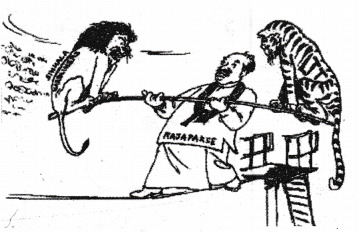
Questions 1. What does the cartoon represent? 2. Which animals do represent Sinhala and LTTE? 3. What does Sri Lankan leadership speak in the cartoon?
Answer: 1. Sri Lanka’s ethnic conflict between LTTE and Sinhala. 2. Sinhala by Lion, LTTE by Tiger. 3. Sri Lankan leadership is supposed to balance both Sinhala hardliners and Tamil militants while negotiating peace. B. On a political outline map of world locate and label the following and symbolise them as indicated:
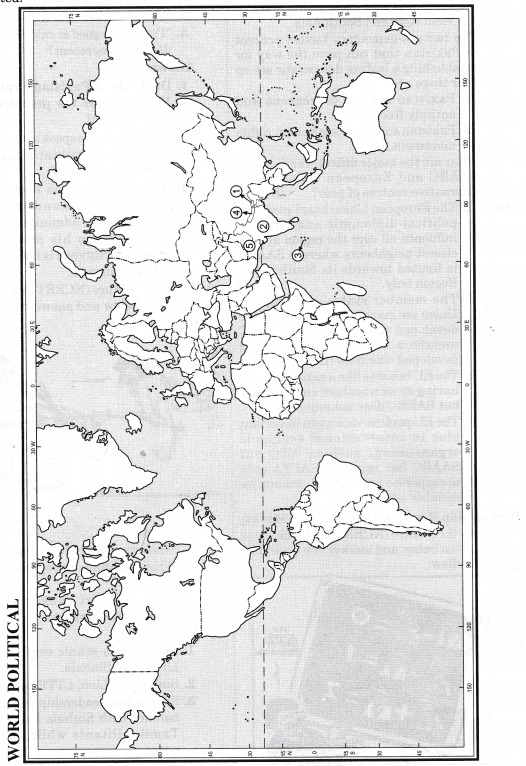
Questions 1. A landlocked country with multi-party competition. 2. Centrally located and shares borders with most South Asian Countries. 3. Earlier the island had Sultan as head, now its a republic. 4. A landlocked country with a monarchy. 5. Country, where military has prevailed over democracy
Answer: 1. Bhutan 2. India 3. Maldives 4. Nepal 5. Pakistan
from Blogger http://www.margdarsan.com/2020/08/ncert-class-12-political-science-world_27.html
0 notes
Text
Imran Khan Speaks With Hasina Wajed: Bold Initiative Towards Bangladesh?
In what appears like a diplomatic coup, PM Imran Khan spoke with Bangladesh's PM, Sheikh Hasina Wajid. He also invited her to visit Pakistan, many suspect that China may have helped bring Pakistan and Bangladesh close to each other - as part of China's silent process of isolating India in the South Asian region.
— News Desk | July 24, 2020 | Globalvillagespace.Com

Prime Minister of Pakistan, Imran Khan on Wednesday expressed his desire for “closer and fraternal” relations with Bangladesh, by speaking to the PM, Sheikh Hasina Wajid.
Mr Khan, in what was his first telephone conversation with his Bangladesh counterpart Hasina Wajed, said: “Pakistan is committed to deepening fraternal relations with Bangladesh on the basis of mutual trust, mutual respect and sovereign equality.”
Imran Khan Takes Bold Initiative Towards Bangladesh
The telephone contact has come after months of efforts to normalise ties between the two South Asian countries after years of deep freeze.
Islamabad’s initiative for mending fences with Dhaka was launched after current high commissioner Imran Siddiqui assumed office in February this year.
Observers were caught by surprise when Mr Siddiqui earlier this month met Bangladesh’s Foreign Minister A.K. Abdul Momen.
Pak-Bangladesh relationship took a nosedive after Ms Wajed started her second tenure as the prime minister in 2009 and she resumed the so-called 1971 trial of the ‘war crimes’.
Pakistan has always considered the bitter past of the 1971 dismemberment as a closed chapter in view of the tripartite agreement signed in April 1974 for repatriation of war prisoners.
Ms Wajed’s father and Bangladesh’s founding father Mujibur Rehman had after the accord agreed that in the interest of regional peace, no one would be put on trial for alleged crimes committed during the 1971 war.
But, Ms Wajed was bent on reviving the ghosts of 1971. She was further emboldened with Indian Prime Minister Narendra Modi’s coming to power in India and Pak-Bangladesh ties went from one low to another.
Pakistan and Bangladesh: Is China Helping?
The contact between the two prime ministers also comes in the backdrop of Delhi-Dhaka ties turning lukewarm following the enactment of controversial Citizenship Amendment Act by India last year. Moreover, growing Chinese influence on Dhaka has also brought Pakistan and Bangladesh closer.
Many analysts in Islamabad – and on Pakistani media – had been predicting that given how Modi regime had treated Bangladesh on CAA issue, China may work upon Bangladesh to take it away from Delhi’s exclusive sphere of influence. These whispers had increased with the Indo-China standoff in Ladakh and with the change in Nepal’s attitude towards Delhi.
It was getting obvious – in Islamabad’s diplomatic circles – that China was flexing its diplomatic muscle in the region around India. It is believed that India’s tiny ally, Bhutan, is also fast improving its relations with Beijing. So it was only a matter of time before Bangladesh too becomes part of the way the regional wind is now blowing.
Imran Khan Invites Hasina to Visit Pakistan
Mr Khan, in his conversation, underscored the importance Pakistan attached to closer ties with Bangladesh and highlighted the significance of regular bilateral contacts and people-to-people exchanges.
He also reaffirmed Pakistan’s commitment to South Asian Association for Regional Cooperation (SAARC) and underlined the importance of both countries working for enhanced regional cooperation for sustainable peace and prosperity.
Mr Khan discussed Pakistan and Bangladesh’s fight against Covid-19 pandemic and extended commiserations on the material and human losses due to the recent flooding in Bangladesh.
He reiterated the invitation to Prime Minister Hasina Wajed to visit Pakistan, the PMO said. However Bangladesh’s PM visiting Pakistan in foreseeable future will be a major regional development, this is something New Delhi will try its best to prevent. India has invested lot of political capital in creating distances between Pakistan and Bangladesh – two Siamese twins separated by Indian intervention in 1971. However SAARC was a creation of Bangladesh and Pakistan and before Sheikh Hasina returned to power in Dhaka, Pakistan and Bangladesh had come closer to each other despite the tragic events of 1971.
Bangladesh Elections 2018 Were Controversial
When Ms. Wajed became the PM of Bangladesh again in 2018, there was much doubt over the fairness of the elections.
The government had promised the election would be free, fair and all-inclusive. Weeks before the election, however, opposition party candidates began reporting attacks by supporters of the ruling Awami League party.
Opposition candidates filed hundreds of complaints with election authorities, alleging ruling party supporters were not allowing them to carry out their campaigns.
Video clips, which claimed to show AL leaders violently threatening opposition party supporters to stay away from polling places, circulated in social media during the run-up to the election.
An op-ed written for GVS last year said that immediately after the elections, many Western countries including the USA, the UK, and EU voiced their concern at the violence, killings and complaints of the opposition regarding stuffed ballot boxes and not letting opposition candidates conduct their election campaigns freely.
The Sheikh Hasina government has regularly arrested anyone who raised their voice against Awami League’s past or present corrupt practices, widespread nepotism, and have allegedly even resorted to killing rivals through fake encounters and extrajudicial killings. The US, in particular, expressed strong concern over the election day irregularities that prevented people from voting undermining faith in the electoral process.
As she came into power, Bangladesh Jamat-e-Islami (BJI), another political rival of Awami League, which had opposed the breakup of Pakistan to create Bangladesh in 1971, was banned as a party for many years, causing some of its leaders to seek exile in Pakistan.
In spite of the above, it is essential for Pakistan to develop and implement a coherent and consistent policy of befriending Bangladesh government and its people. Pakistan needs to take concrete steps to formulate an articulate narrative about the 1971 war based on historical facts, including India’s role in a proxy war which resulted in thousands of deaths, rapes, arson, loot and destruction, eventually resulting in Pakistan’s dismemberment.
0 notes
Text
Thailand targets 2023 for the BULLET TRAIN
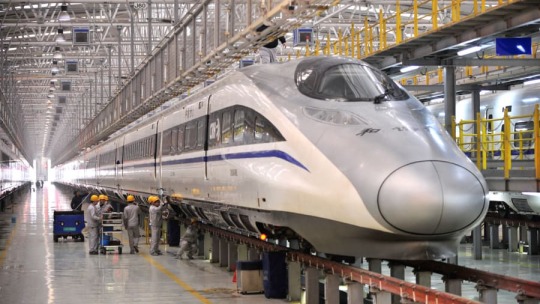
After years of delays and much debate, it's finally happening. #Bullettrains are coming to #Thailand.
With one project under construction, another approved and others being considered, many in the country are questioning whether high-speed rail (HSR) will be the right fit for the country. "This is going to be a big change for Thailand," says Thanet Sorat, an adviser to Thailand's Senate Committee on Transportation, vice president of shipping company, V-Serve, and president of the Thai Authorized Customs Brokers Association. He hopes to see sleek trains pinballing around the country at 155 mph (250 kph) within five years. Both projects currently in the works will employ Chinese HSR technology. Though Thailand declined Chinese loans, the projects are considered a part of the Belt and Road Initiative (BRI), a plan that aims to connect China to the rest of Asia through new transport infrastructure. Bangkok to Pattaya in 45 minutes Expected to open in 2021 to replace Bangkok's 103-year-old Hualamphong Station, a massive new rail hub in the city's Bang Sue district will serve passengers using both HSR and the country's existing railway network, which is being upgraded from single to dual track. Tied to this, on October 24, a conglomerate led by Thailand's CP Group signed a contract with the State Railway of Thailand (SRT) for the construction of a HSR line linking Bangkok's two airports, Suvarnabhumi and Don Mueang, to three eastern provinces. It will operate in addition to the existing Airport Rail Link, an elevated train that connects Suvarnabhumi to Bangkok's metro system. The planned line, beginning from Don Mueang then passing through Bang Sue, will also stop at Makkasan in central Bangkok before proceeding to Chachoengsao, Chonburi, Sriracha and Pattaya, a major tourist destination located 75 miles (120 km) south of Bangkok on the Gulf of Thailand. Expected to begin service in 2024, the 137-mile line will terminate at U-Tapao Airport, outside of Pattaya in Rayong province.
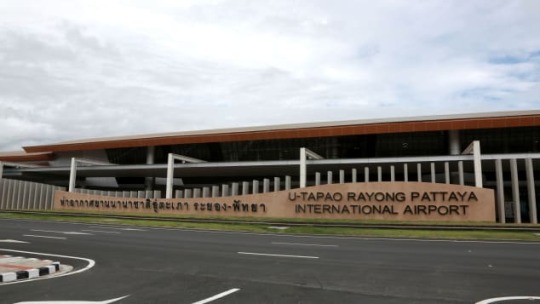
The new line will connect Bangkok's two airports with U-Tapao Airport in Rayong province, an industrial and fishing hub.- Pailin Wedel/Bloomberg/Getty Images The government plans to move some 10% of flights from Bangkok to a redesigned U-Tapao in order to ease congestion at Suvarnabhumi and Don Mueang. "To do that, they need a transportation link between the airports, and it could be a good opportunity for HSR," says Jittichai Rudjanakanoknad of Chulalongkorn University's Department of Civil Engineering. A conglomerate led by Thailand's Charoen Pokphand Group (CP), which also includes the China Railway Construction Corp., will cover an investment of 224 billion baht ($7.4 billion) in exchange for real estate concessions and a 50-year license to operate the line. One goal is to provide easy access to the Eastern Economic Corridor (EEC), a zone that Thanet says constitutes 80% of total foreign investment in Thailand.
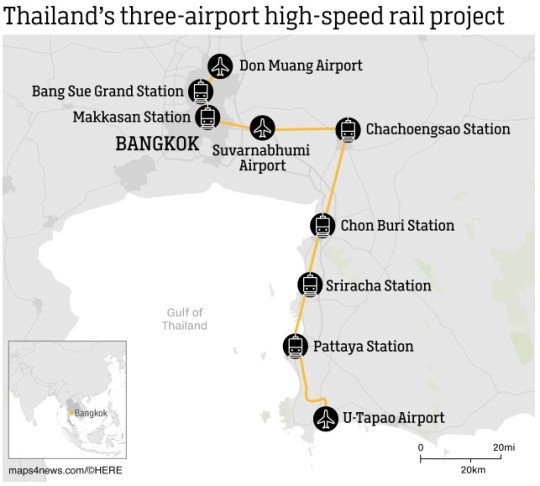
Supporters point out that HSR will reduce travel time between Bangkok's two airports to just 20 minutes, and shuttle tourists to Pattaya in less than an hour. They also predict it will reduce traffic on highways, curtailing accidents in a country with one of the world's highest road fatality rates. As it stands, transferring between Suvarnabhumi and Don Mueang entails a shuttle bus journey that can last an hour or more during Bangkok's notoriously sluggish rush hours. Reaching Pattaya from Suvarnabhumi requires haggling with a taxi driver, taking a cramped van or traveling across town to catch a bus from Ekkamai Terminal for the two-hour ride. "Linking the three airports is a noble objective," says Ruth Banomyong, director of the Center for Logistics Research at Bangkok's Thammasat University. But he and other critics question whether HSR is the right choice, given the high cost and relatively short distances involved. Some argue that dual-track rail would suffice for the eastern provinces, which currently lack any railway at all. The SRT said in September that 80% of land needed for the three-airport line has been secured for expropriation, and the Bangkok Post has reported that 3,000 houses will need to be demolished. Adding that gas and electrical lines may also be affected, Jittichai says, "it's not easy to relocate people. Some are going to court and it takes quite a long time." Bangkok to Khorat in 77 minutes

Construction of the China-Laos railway is now underway in Yunnan province. - Ren Dong/China News Service/Visual China Group/Getty Images Expected to open in 2023, Thailand's maiden HSR line is now under construction beside existing railway tracks in Nakhon Ratchasima, a northeastern province also known as Khorat. Unlike on the three-airport line, Chinese state firms are responsible for nearly all of the construction. Beginning at Bang Sue, this 157-mile "Khorat line" will stop at Don Mueang Airport and the historic capital of Ayutthaya before cutting northeast to Saraburi and Pak Chong near the popular Khao Yai National Park. It will terminate at Khorat -- at least until the track is extended. The government's long-term plan is to extend the line north to Nong Khai, located 370 miles (600 km) northeast of Bangkok and home to a popular border crossing that enables travelers to reach the Lao capital of Vientiane. After crossing the Mekong River on a new bridge, passengers would be able to continue north on another HSR line now being built in Laos. The ultimate goal is to link these lines with Kunming in southern China's Yunnan province. The Khorat line has drawn more criticism than the three-airport line due to the investment of 179 billion baht ($5.9 billion) worth of public funds. Critics argue that northeast Thailand is not on the agenda for most tourists, while also expressing frustration about a lack of transparency when Thailand's military government approved the project in 2017. In a report first published by The Diplomat, Pechnipa Dominique Lam of the Thailand Development Research Institute estimated the line "would need to ferry 50,000-85,000 passengers every day for 20 years in order to pay back the costs of investment." At only 5,000-25,000 riders per day, the Transport Ministry's own forecasts fall well short of those numbers.
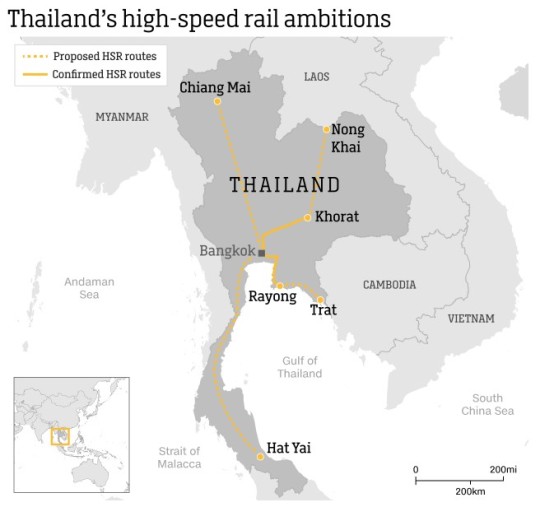
"Taking into account the benefits arising from the HSR, such as passengers' time savings on travel," she went on, "the economic case in favor of doing the project is still outweighed by its financial losses." "This line is mostly influenced by China," adds Jittichai. "If Thailand builds it, we might not get much benefit. But if we don't build it, we could lose other benefits from China. That is what the government is thinking." Competitive transport market
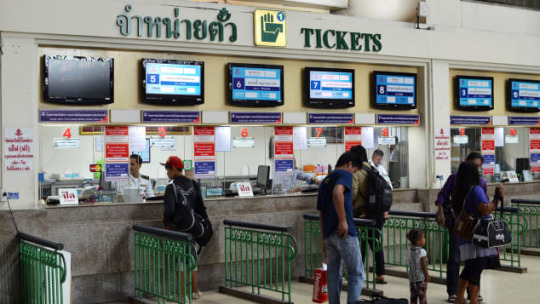
Both the SRT and the state-run bus service have long been operating at a deficit. - David Luekens "There is a strong risk that HSR might not be successful because of existing transport connectivity," according to Ruth. Both the SRT and the state-run bus service have long operated at financial losses as passenger numbers decline each year. The state-run airline, THAI, is also struggling as budget carriers like Air Asia and Nok Air compete with fares from Bangkok to more than 20 other Thai cities for as little as $20. Critics also wonder if enough Thai people can afford HSR in a country with a notably wide economic divide and a minimum wage of only 300 baht ($10) per day. Although most middle-class Thais can manage the proposed 330 baht fare for a bullet train from Bangkok to U-Tapao, and 500 baht to Khorat, many of them are attached to their private automobiles. As for the working class, they may end up sticking to buses and vans that cost roughly a quarter of the proposed ticket prices for HSR. Regular trains are even cheaper and the coming dual tracks will shorten travel times on existing railway lines, adding another layer of competition. While waiting for a train at Khorat's 119-year-old railway station, Daeng Tungsunern, a Khorat native who sells second-hand goods, tells CNN, "I did not know about the HSR project until it was already being built. I will not use it because it will be too expensive for my budget." "Just like in Japan"
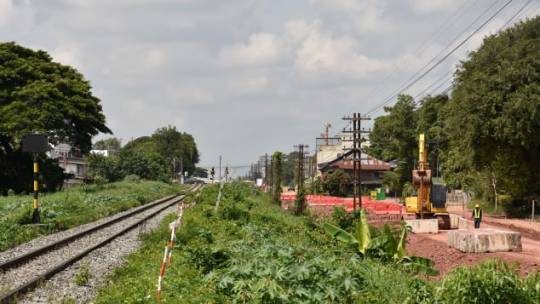
HSR track construction is now taking place beside the existing single rail track in Noen Sung district, Nakhon Ratchasima province. - David Luekens In the future, Thanet envisions Thailand as a central hub in a Southeast Asia linked by bullet trains. He also sees value in the transfer of technology, suggesting that "20 years into the future, we should be able to produce high-speed trains ourselves and not only buy them from China or Japan." Jittichai agrees HSR could become worthwhile "if looking at a broader network, for example, if the Thai lines can be connected to the Chinese network or Singapore, or even to central Asia and Europe." To that end, the government is considering additional HSR lines running north from Bangkok to Nakhon Sawan, Phitsanulok and Chiang Mai; south through Hua Hin, Surat Thani and Hat Yai; and further east from Rayong to Chanthaburi and Trat near Cambodia. Subsequent projects might extend the proposed southern line through Malaysia to Singapore, while a northern line could link with a western extension to Myanmar and onwards to India. The SRT is already promoting these additional projects, but the extremely high price tags are likely to prohibit them from taking shape any time soon. "If the cost of construction and technology becomes cheaper, that is when you will see these other lines," says Jittichai. Back inside Khorat's railway station, Paitoon Tikul, a retired soldier who rides trains and his bicycle around Thailand to raise money for charity, says, "I think HSR will be useful for certain people. But the cost of these projects is very expensive, and I worry about corruption. In my opinion, it would be better to use that money for improving schools, hospitals and more useful things." As a roughly 50-year-old train clinks into the station, railway police captain Nutthawoot Sawanphomrat interjects, saying "I think HSR will be good for the country and the economy. Just like in Japan." – You can follow BangkokJack on Instagram, Twitter & Reddit. Or join the free mailing list (top right) Please help us continue to bring the REAL NEWS - PayPal Read the full article
0 notes